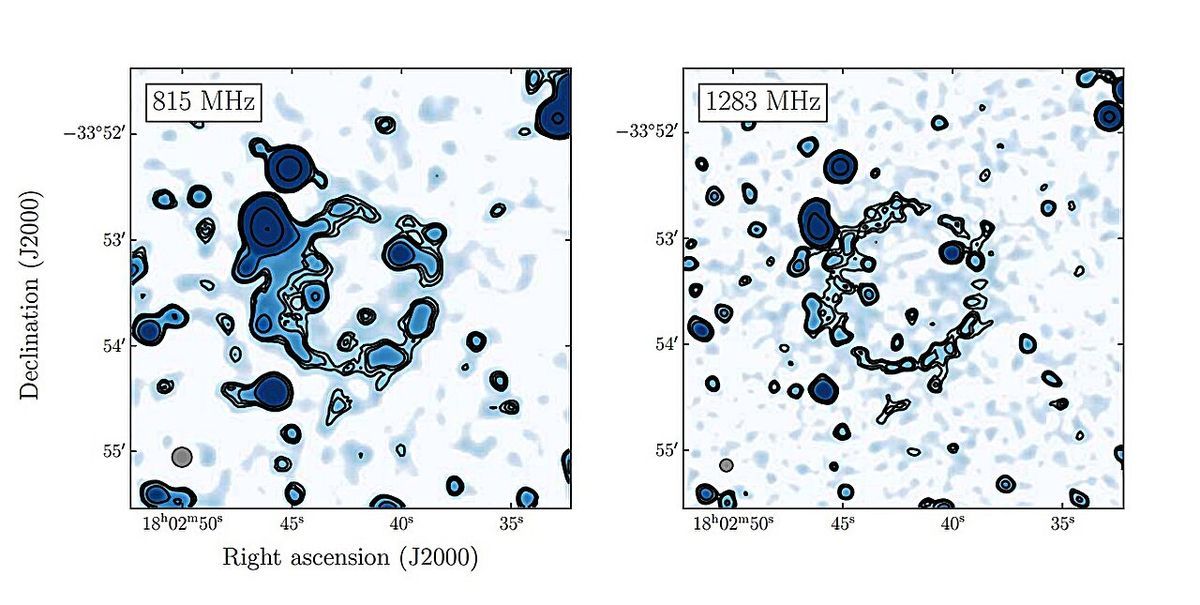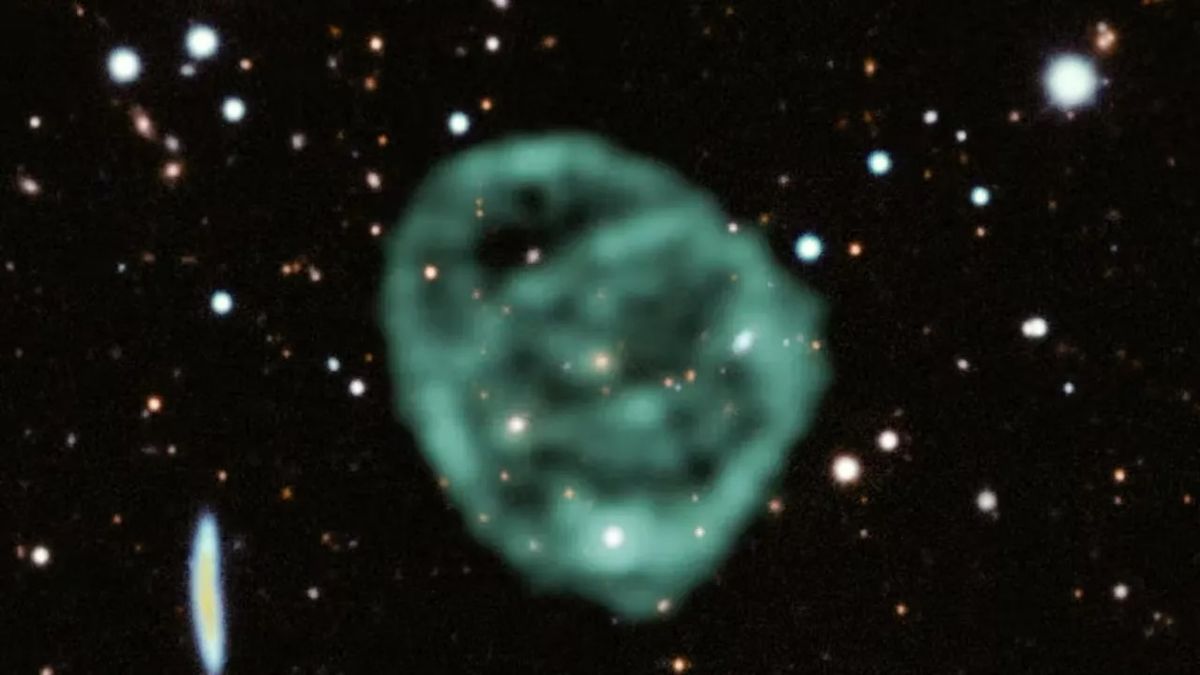A mysterious ring of radio light could have been created by a type of massive star with a powerful wind of radiation blowing away its outer layers, according to astronomers who made the discovery with the MeerKAT radio telescope in South Africa.
In 2019, astronomers conducting a survey with the Australian Square Kilometer Array Pathfinder telescope, or ASKAP, noticed several strange rings of radio light, undetectable at any other wavelength of light and with no obvious source. The astronomers called them ‘odd radio circles’, or ORCs for short.
Only a handful are currently known, but now a new ORC has been discovered that breaks all the rules.
ASKAP is a technological precursor to the Square Kilometer Array (SKA), which will be a giant array of radio dishes and antennas split between Australia and South Africa. So it’s fitting that South Africa also has its own SKA precursor observatory, in the form of MeerKAT, originally the Karou Radio Telescope, based in the country’s Meerkat National Park.
It was in observations made with MeerKAT in November 2022 that astronomers led by Cristobal Bordiu of Catania Observatory in Italy spotted something out of the ordinary. It was an ORC, but it’s not where it is supposed to be.
Related: Scientists have discovered a mysterious repeating radio signal from deep space
Prior to this discovery, all previous ORCs had been found at high galactic latitudes. In other words, they are high above the plane of our Milky Way galaxy, meaning that they are either very close to us within our galaxy, or they are extragalactic. Indeed, several ORCs contain a galaxy in the middle of the ring, and those ORCs are thought to have been produced by an outburst from that galaxy, perhaps from a starburst event resulting in lots of supernovas, or a merger between two supermassive black holes resulting in a pulse of energy.
This new ORC, however, is just six degrees above the plane of our galaxy, slap bang in the Milky Way as presented on the sky. Furthermore it appears, from our point of view, to be quite close to the galactic center. However, that could just be a coincidence — it could be much closer, or much farther away, than the center of our galaxy, which is 26,000 light-years away.
The ORC, cataloged as J1802–3353, has been nicknamed Kýklos by its discoverers, a word that means circle in Greek. Kýklos spans 80 arcseconds in the sky — one arcsecond is 1/3,600th of a degree. The ring itself is only seen at radio wavelengths, where it is faint, patchy, thin (just 6 arcseconds thick) and almost a perfect circle. Its radio spectrum is surprisingly flat, meaning that it doesn’t have any notable spectral lines unlike previous ORCs.
Bordiu’s team realized that this ORC could be something new, but before they could determine that, they had to rule out the other possibilities.

The European Space Agency‘s Gaia mission has cataloged three galaxies that all happen to lie within Kýklos on the sky. One galaxy in particular is just 3 arcseconds from the center of the ring, but if Kýklos was produced by this galaxy then explaining why it has such a flat spectrum compared to other ORCs connected to galaxies would be a challenge.
If Kýklos is not extragalactic, then it must be in our Milky Way galaxy, which suggests a stellar origin. Supernova remnants are often round nebular structures produced by the blast wave from an exploding star colliding with the gas and dust in the interstellar medium.
However, supernova remnants usually produce X-rays too, and no X-rays have been detected coming from Kýklos. Although several pulsars, which are spinning neutron stars created by some supernovas, have been detected inside the ring from our point of view, we have no distance information about them to say whether they are connected to the ring or whether their location is merely a line-of-sight coincidence.
Perhaps Kýklos is a planetary nebula, which is the cast-off envelope of a dying sun-like star. A planetary nebula usually grows to about 3 light-years wide before dispersing; if Kýklos were a planetary nebula it must be an abnormally large one, or be reasonably close to us, to appear 80 arcseconds wide in the sky. (For comparison, possibly the most famous planetary nebula is the Ring Nebula in the constellation of Lyra, which is 230 arcseconds wide at a distance of 2,200 light-years.) However, a planetary nebula produces optical emission, specifically in hydrogen-alpha light, but no such light has been detected.
Instead, perhaps the ring has been produced by a massive, unstable star, specifically a Wolf–Rayet star. Because a Wolf–Rayet star is so massive, it is able to generate a powerful wind of radiation that blows its outer layers deep into space, reducing its mass and making it more stable. Wolf–Rayet stars are often recognized either through the nebula that they blow, or by their composition — with their hydrogen envelope cast adrift, the heavier elements such as helium and oxygen within their deeper layers are exposed.
Although no Wolf–Rayet nebula is apparent within Kýklos, this is not a problem since a Wolf–Rayet star’s fast radiation wind quickly destroys the dusty nebula close to it. Colder dust farther out would survive and radiate at 24 microns, but Bordiu’s team point out that there is no data available at this wavelength to be able to say whether this colder dust is present or not. However, there is other evidence to support the Wolf–Rayet star scenario, which is the flat spectrum that is very typical of this type of star shedding mass.
“Based on the limited data currently available, the morphological and spectral characteristics of Kýklos appear more consistent with those of a Wolf–Rayet shell,” Bordiu’s team wrote in their research paper.
It is true that a Wolf–Rayet star has not yet been identified inside Kýklos yet. There is one bright star, HD 164455, but it is not a Wolf–Rayet star. Gaia has identified three other stellar candidates, including one bluish star that is 24,500 light years away from us. If this is the source of Kýklos, then at that distance the ring would be about 10 light-years across. However, there’s no spectral data on this star to say whether it is a Wolf–Rayet star or not.
The next step, therefore, will be to follow up with the James Webb Space Telescope and obtain that data to potentially solve the mystery of Kýklos.
The findings have been accepted for publication in the journal Astronomy & Astrophysics, and a preprint version is available on arXiv.
Originally posted on Space.com.

